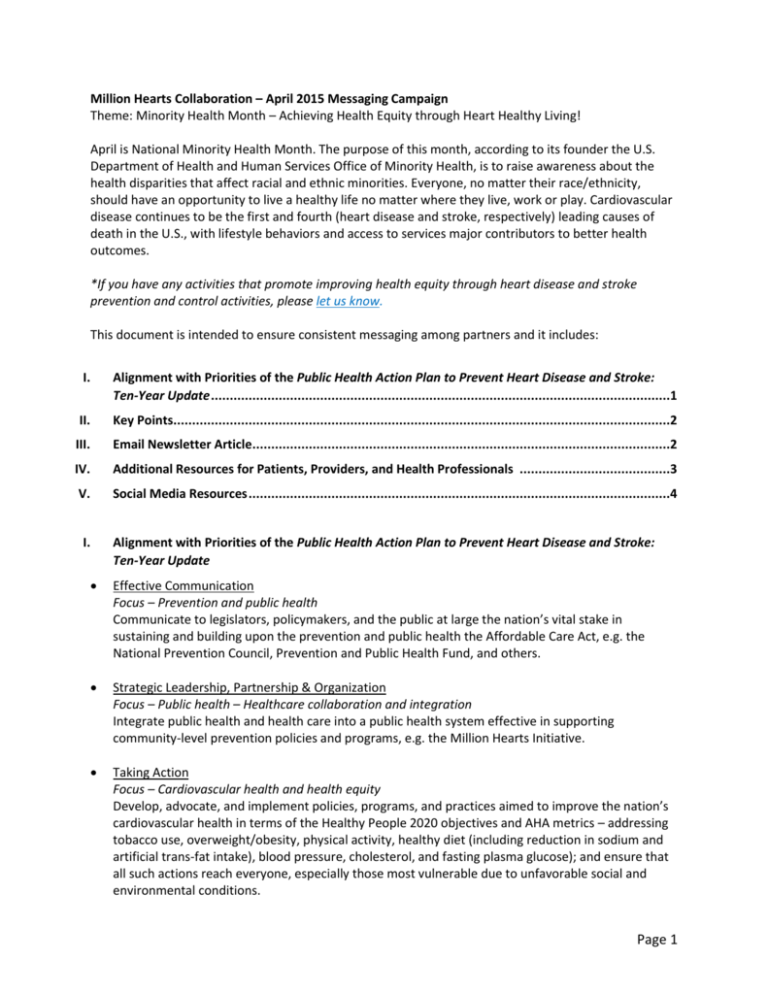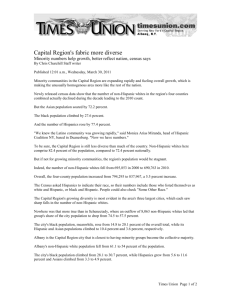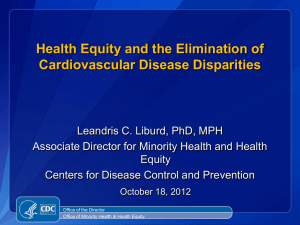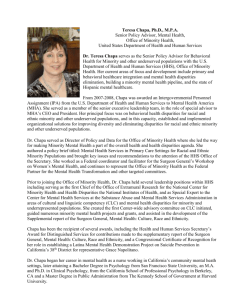April 2015 Messaging Campaign
advertisement

Million Hearts Collaboration – April 2015 Messaging Campaign Theme: Minority Health Month – Achieving Health Equity through Heart Healthy Living! April is National Minority Health Month. The purpose of this month, according to its founder the U.S. Department of Health and Human Services Office of Minority Health, is to raise awareness about the health disparities that affect racial and ethnic minorities. Everyone, no matter their race/ethnicity, should have an opportunity to live a healthy life no matter where they live, work or play. Cardiovascular disease continues to be the first and fourth (heart disease and stroke, respectively) leading causes of death in the U.S., with lifestyle behaviors and access to services major contributors to better health outcomes. *If you have any activities that promote improving health equity through heart disease and stroke prevention and control activities, please let us know. This document is intended to ensure consistent messaging among partners and it includes: I. Alignment with Priorities of the Public Health Action Plan to Prevent Heart Disease and Stroke: Ten-Year Update ..........................................................................................................................1 II. Key Points....................................................................................................................................2 III. Email Newsletter Article...............................................................................................................2 IV. Additional Resources for Patients, Providers, and Health Professionals ........................................3 V. Social Media Resources ................................................................................................................4 I. Alignment with Priorities of the Public Health Action Plan to Prevent Heart Disease and Stroke: Ten-Year Update Effective Communication Focus – Prevention and public health Communicate to legislators, policymakers, and the public at large the nation’s vital stake in sustaining and building upon the prevention and public health the Affordable Care Act, e.g. the National Prevention Council, Prevention and Public Health Fund, and others. Strategic Leadership, Partnership & Organization Focus – Public health – Healthcare collaboration and integration Integrate public health and health care into a public health system effective in supporting community-level prevention policies and programs, e.g. the Million Hearts Initiative. Taking Action Focus – Cardiovascular health and health equity Develop, advocate, and implement policies, programs, and practices aimed to improve the nation’s cardiovascular health in terms of the Healthy People 2020 objectives and AHA metrics – addressing tobacco use, overweight/obesity, physical activity, healthy diet (including reduction in sodium and artificial trans-fat intake), blood pressure, cholesterol, and fasting plasma glucose); and ensure that all such actions reach everyone, especially those most vulnerable due to unfavorable social and environmental conditions. Page 1 II. Key Points Race and ethnicity is associated with a person’s risk for heart disease and stroke. o African Americans are at greater risk for cardiovascular disease than other races/ethnicities, with 2 out of 5 African Americans at risk for heart disease compared to 1 in 4 among the general public. o The rates of premature death (death before age 75 years) from stroke and coronary heart disease were higher among non-Hispanic blacks than among whites. o Women, minority racial/ethnic groups (except Asian/ Pacific Islanders), the less educated, those who spoke a language besides English at home, and those with a disability were more likely to report fair or poor self-rated health, more physically unhealthy days, and more mentally unhealthy days than others. Race and ethnicity is associated with a person’s risk for factors that impact heart disease and stroke. o Diabetes prevalence was highest among males, persons aged ≥ 65 years, non-Hispanic blacks and those of mixed race, Hispanics, persons with less than high school education, those who were poor, and those with a disability. o Rates of blood pressure control among adults with hypertension were lowest among Mexican Americans, persons without health insurance, those who were never married, and those born outside the United States. o Persons living in rural census tracts, or living in areas with a higher percentage of senior citizens, or with a higher percentage of non-Hispanic whites, more often lacked at least one healthier food retailer nearby (within ½-mile of the tract boundary) compared with persons living in other census tracts. The Guide to Community Preventive Services Task Force recommends system interventions to improve CVD risk factors, including clinical decision support systems, reducing out-of-pocket costs for CVD preventive services for patients with hypertension and high cholesterol, and team-based care to improve blood pressure control. Data derived from the CDC Health Disparities and Inequalities Report — United States, 2013, Section on Coronary Heart Disease and Stroke Deaths: Report III. Email Newsletter Article This month’s message focus is on minority health. Why? April is National Minority Health Month. The purpose of this month, according to its founder the U.S. Department of Health and Human Services Office of Minority Health (OMH), is to raise awareness about the health disparities that affect racial and ethnic minorities. This is extremely important, as minorities are, often at times, more susceptible to the risks for heart disease and stroke and to cardiovascular disease. For example, OMH has looked at the disparities in heart disease and stroke, the first and fourth leading causes of deaths in the US, and found that: Page 2 In 2010, African Americans were 30 percent more likely to die from heart disease, as compared to non-Hispanic Whites. Although African American adults are 40 percent more likely to have high blood pressure, they are half as likely than their non-Hispanic White counterparts to have their blood pressure under control. In general, Hispanic American adults are less likely to have coronary heart disease than non-Hispanic White adults. They are also less likely to die from heart disease than non-Hispanic White adults. But, they are less likely to have their high blood pressure under control than non-Hispanic whites, a risk factor for diabetes. Hispanics are almost twice as likely as non-Hispanic whites to be diagnosed with diabetes, a major risk factor for heart disease, by a physician. American Indians/Alaska Natives, on average, are more likely to be diagnosed with heart disease than their white counterparts. In addition, American Indians/Alaska Native adults are more likely to be obese than white adults, more likely to have high blood pressure, and they are more likely to be current cigarette smokers than white adults - all risk factors for heart disease. The OMH Website has resources, including social media messages, sample event calendars, and graphic materials, for download. Site visitors can also download the National Partnership for Action to End Health Disparities Toolkit for Community Action, which helps groups interested in raising awareness about and/or implementing systems to address health disparities and engage others in conversations about the problems and solutions, and take action for change. Other organizations can provide tools to tackle health disparities too. The Community Guide to Preventive Services has recommendations to Promote Health Equity, which include interventions for education programs and policies, culturally competent healthcare, and housing program and policies. Additionally, the American Heart Association hosts EmPOWERED to Serve™, a megacommunity made up of a group of individuals from various organizations, businesses and government that come together to focus on improving health in multicultural communities. This group shares best practices, develops strategies and, ultimately, helps to drive a "sustainable culture of health" within the nation. There are a lot of ways you can help reduce health disparities in your community. You can make a difference and increase healthy living options for all! IV. Additional Resources for Patients, Providers, and Health Professionals Million Hearts® Collaboration Partners Featured Resources American Heart Association – The AHA website maintains a wealth of resources to inform on and assist in monitoring, heart disease and stroke conditions, risk factors and healthy behaviors. My Life Check Life's Simple 7 offers interactive tools, such as My Heart Score (English) and Mi puntuaciÓn corazÓn (Spanish), on the seven simple steps to Manage Blood Pressure, Control Cholesterol, Reduce Blood Sugar, Get Active, Eat Better, Lose Weight and Stop Smoking. Go Red por tu corazon provides information in Spanish. Centers for Disease Control and Prevention – CDC’s Office of Minority Health & Health Equity (OMHHE) invites you to celebrate Minority Health Month! This year's theme is Advance Health Equity Now: Uniting our Communities to Bring Health Care Coverage to All! CDC and HHS are focused on highlighting strategies and actions leading to Health Equity. Go to CDC Activities for Minority Health Month for more information. Page 3 Recognizing the substantial value CHWs bring to heart disease and stroke prevention, CDC has compiled evidence-based research that supports the effectiveness of CHWs in our Community Health Worker Toolkit. The toolkit includes information state health departments can use to train and further build capacity for CHWs in their communities, as well as helpful resources that CHWs can use within their communities. Available resources include: Online training materials such as Fotonovelas, a CHW sourcebook, and e-learning course Technical assistance and policy materials such as policy evidence assessment reports, a summary of CHW-related laws, and updated policy brief Million Hearts® – The 2014 Hypertension Control Champions include private and tribal clinical practices and health services, ranging from solo practitioners to large systems and representing both urban and rural areas. Together they care for more than 3.5 million adult patients in 19 different states. Each Champion was able to achieve hypertension control rates of 70 percent or more. 2014 Hypertension Control Champions Message to Millions: Message Maps Messages to Millions is designed to provide consistent, science-based Million Hearts® messages to disseminate to partners and supporters on a quarterly basis. Message maps provide key and supporting messages that stress the steps that can be taken by consumers, health care providers, and other audiences to help prevent heart attacks and strokes. The messages can be adapted for other audiences. Message to Millions: Hypertension Control Message Map [PDF-302K] Message to Millions: Tobacco Cessation Message Map [PDF-262K] Message to Millions: Sodium Message Map [PDF-270K] Million Hearts® Partners Featured Resources V. Social Media Resources Pages and Handles AHA Twitter AHA Facebook CDC Twitter CDC Facebook Million Hearts Twitter Million Hearts Facebook National Forum Twitter National Forum Facebook Twitter Posts .@CDCgov has compiled evidence-based research that supports effectiveness of CHWs in Community Health Worker Toolkit http://1.usa.gov/1EfYE8K Looking for information to train and build capacity for CHWs in your community? Checkout NEW @CDCgov toolkit http://1.usa.gov/1EfYE8K Checkout NEW @CDCgov Community Health Worker Toolkit for helpful resources CHWs can use in their communities http://1.usa.gov/1EfYE8K DYK: African Americans were 30% more likely to die from heart disease than non-Hispanic Whites #minorityhealthmonth Page 4 .@MillionHearts is celebrating #minorityhealthmonth. Are you? Retweet if you are too. [include picture or company graphic] .@CDCgov has activities planned throughout minority health month. Visit to learn what you can do this month: http://www.cdc.gov/minorityhealth/observances/MH.html. The #CDC Office of Minority Health and Health Equity is 25 years old this year. Retweet to celebrate them and #minorityhealthmonth! Find out what you can do to end health disparities in the U.S.: http://www.minorityhealth.hhs.gov/npa/files/Plans/Toolkit/NPA_Toolkit.pdf Facebook Posts Minorities are, often at times, more susceptible to the risks for heart disease and stroke and to cardiovascular disease. Find out what you can do to address health disparities in your neighborhood: http://www.minorityhealth.hhs.gov/npa/files/Plans/Toolkit/NPA_Toolkit.pdf. African American adults are 40% more likely to have high blood pressure than their non-Hispanic White counterparts. Find out what organizations are doing about it: http://empoweredtoserve.heart.org/about. Hispanics are almost twice as likely as non-Hispanic whites to be diagnosed with diabetes, which is a major risk factor for heart disease. Share Go Red por tu corazon with Spanish-speaking families and friends who want to learn more about heart disease and stroke prevention and treatment. Million Hearts is celebrating National Minority Health Month. Are you? Share if you are. [Include picture and/or company graphic] Page 5







